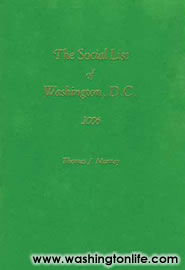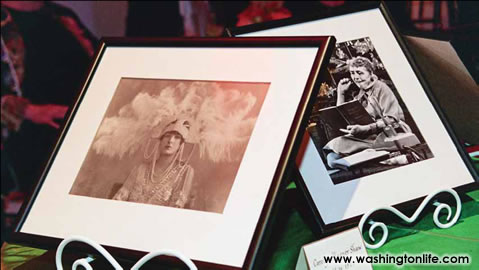The Green Social Guard The Green Social Guard
|
||||||||||||||
 |
At 75, the old gal in green is exceedingly well-preserved and still veddy veddy proper.
And still—like Caesar at the ancient Coliseum— declaring thumbs up or down on those hoping to be included in the official Society List for Washington.
Begging, bribing or bartering to get listed is simply not done. In the old days, if you were known as an “F.P.” (Fanny Pincher) or B.D. (Bad Drunk) you could be ousted on your white-tailed tushy. Better known as “The Green Book” for it’s emerald felt cover, the list includes members of Congress and the administration, appointees, Supreme Court Justices, ambassadors, and hundreds of socially connected gentlefolk.
It all began in 1930 when an enterprising Helen Ray Hagner—herself a well-connected debutant—began collecting guest lists for other party-goers. She set up a small desk at the Shoreham Hotel, dubbed it The Social Bureau of Washington, and sold the book for $12, only to those whose names were included. This was the original swell set; pedigrees, gowns by Patou, family jewels, and memberships in all the right clubs (Metropolitan, Sulgrave, Chevy Chase). If you were not included you were simply in Social Siberia. Quelle horreur! Death by shrimp fork.
Of course all that has changed. Or has it?“People killed to be in the Green Book,” former White House social secretary Letitia Baldridge says.
They planned and plotted and persuaded their friends to write the all-important letters of recommendation. Then, each October, the book arrived in a brown cardboard box. It took the listees days to page through it, looking to see who was in, and who was out. Famous names could be dropped for various reasons: blabbing too much about a White House wedding (socialite and author Barbara Howar), coarse behavior (White House aide Hamilton Jordan) murdering your lover (former Madeira School headmistress Jean Harris) and of course, going through a messy split from one’s spouse.
“I was in twice,” says former gossip columnist Diana McLellan. “Then I got banned after my divorce.”
After The Washington Post’s Ben Bradlee was dropped following his divorce, he tongue-incheek declared it a “cruel, cruel blow.” Supreme Court justice Abe Fortas was dropped for bad behavior. So was his colleague, Supreme Court Justice William O. Douglas, when he married a woman his granddaughter’s age. A notation on his file card reading “O.F.” (Old Fool).
The Green Book—now much less exclusive and mostly used as a private telephone directory— is assembled in a small basement office adjacent to a garage in Kensington, Maryland, is still run by relatives of Mrs. Hagner. Her daughter Carolyn Hagner Shaw took over editing duties in 1943 and gradually added telephone numbers and glossy advertisements to the book. A more flamboyant type, “Callie” Shaw was a divorcee herself, who enjoyed a martini or two. Strapped for cash, she would often put out two or three editions a year of the Green Book whenever bills were overdue. Now the book costs $75, and is still privately published by Thomas J. Murray, Jr., Callie’s 81-year-old son-in-law.
Never mind that some members had gone to that great ballroom in the sky. Like the prominent Washingtonian whose dying wish was to be buried in white-tie-and-tails. There was only one problem; the funeral was at 2 p.m., hours before any sane patrician would ever don such apparel. A call to the Green Book assured his widow that indeed, it would be quite all right.
Ignoramuses from the sticks could look up various crucial laws of protocol, including the “social call” where you were expected to pay a personal 15-minute visit to complete strangers to introduce yourself as a member of “society.” Monday was for the wives of the Supreme Court justices, Tuesday for Congressional wives, Wednesday the wives of the Cabinet, Thursday the Senate and Friday the wives of foreign diplomats.The Green Book still provides guidance for this ancient ritual.
Then there were the big names. When James Earl Carter was elected president, The White House social staff insisted that he be listed as “Jimmy” Carter. The Green Book obliged, with a listing that read, “Carter, the President of the United States and Mrs. Jimmy.”
The Old Guard was once restricted to WASPS and a few other denominations. Jews were blackballed, and nouveau types dismissed as arrivistes. Now the Green Book has many Jewish names. The first blacks were included in 1971, when the diplomatic Mrs. Shaw declared that “time moves on.”
Last month to celebrate the 75th anniversary, The Green Book hosted a staid but proper affair at the City Museum. A number of longtime listees were there, mostly white haired and nostalgic. It was the first official party the Green Book has ever hosted.
Perhaps every 75 years is enough.
Today, dot-commers, investment bankers and commercial real estate developers are prominent in what used to be known as Social Washington. “Ladies Who Lunch” have gone the way of seamed stockings. Still, looking through Mr. Murray’s scrapbooks and old copies of the Green Book is a fascinating time trip. It all seems so quaint: when women actually dressed for dinner and were segregated from their cigar-smoking husbands, when social icons Alice Longworth Roosevelt, Virginia Bacon, Marie Beale, Mildred Bliss, Cissy Patterson, and later Marjorie Meriweather Post, Evangeline Bruce, Pam Harriman, Polly Guggenheim Logan and Katharine Graham reigned. When hats were de rigueur, calling cards engraved and no one would have dared sit next to a “F.P.” at dinner
 |
 |
